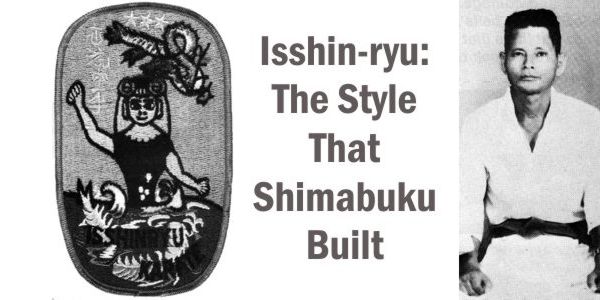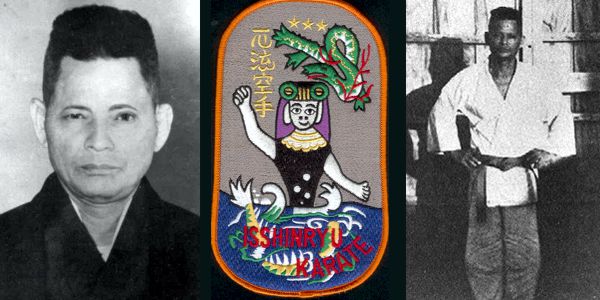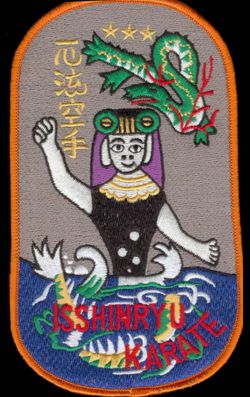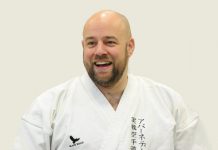 Isshin-Ryu karate was founded by one of the great karate masters, Tatsuo Shimabuku, and is derived from several of the other, older classical styles.
Isshin-Ryu karate was founded by one of the great karate masters, Tatsuo Shimabuku, and is derived from several of the other, older classical styles.
Master Tatsuo Shimabuku, began learning karate at the age of 14 and devoted the rest of his life to its study and teaching. For 26 years he studied the other styles, Shuri-Te, Shorin-Ryu and Goju-Ryu, each one under the master of its style.
Master Shimabuku took the best of each style, improved it and founded Isshin-Ryu. From Master Motobu, Master of Shuri-Te, he took the kumite; from Master Kiyan, Master of Shorin, he took the Kata and added improvements; from Master Miyagi, Master of Goju, he took Sanchin, the basis of all Okinawan karate.
Isshin-Ryu, with roots going back 500 years, is a postwar development, modernized to meet the needs of today’s world. It was founded in the 50’s and has been taught ever since to American Marines stationed in Okinawa.
Shimabuku’s reputation throughout Okinawa had reached its peak when WorldWar II struck the island. A business man as well as a karate teacher, the sensei’s small manufacturing plant was completely demolished and he was bankrupt almost from the war’s outset. He did his best to avoid conscription to the Japanese Army by escaping to the countryside where he worked as a farmer. As the situation grew more and more desperate for the Japanese and as the need to press the Okinawans into service became urgent, he was forced to flee.
As his reputation in karate spread among the Japanese, many soldiers began a thorough search as they wanted to study karate under him. The officers who finally caught up with him agreed to keep the secret of his whereabouts if he would teach them karate; it was in this manner that Master Shimabuku survived the war.
After the war, his business ruined and little chance of earning a living by teaching karate on the war-ravaged island, Master Shimabuku returned to farming and practiced karate privately for his own spiritual repose and physical exercise. Throughout Okinawa, he was recognized as the island’s leading practitioner of both Shorin-Ryu and Goju-Ryu Karate.
In the early nineteen fifties, the sensei began to consider the idea of combining the various styles into one standard system. He could forsee the problems that were developing out of the differences among styles; he sagely concluded that a unification or synthesis of styles would enhance the growth of karate.
He consulted with the aged masters on the island, and with the heads of the leading schools. At first there was general agreement, but later his idea met resistance as the leaders of the various schools began to fear loss of identity and position. Sensei Shimabuku decided to go ahead on his own; thus Isshin-Ryu Karate was born. On May 30, 1975, Master Shimabuku passed away, leaving a legacy to the world of karate, and to all the future Isshin-Ryu students.
 Mizu Gami
Mizu Gami
The Isshin-Ryu symbol represents a vision that Master Shimabuku had while formulating Isshin-Ryu.
One day after working very hard creating Isshin-Ryu, Master Shimabuku fell asleep. He dreamed that a man came into his dojo and challenged him. He declined the challenge saying he was a gentleman and did not fight unless necessary. Then a figure appeared over the man, that of a dragon. The dragon spit fire all around the Master. As the ring of fire drew closer, a figure appeared over Master Shimabuku, and put out the fire. The figure was that of Mizu-Gami (Water Goddess).

Master Shimabuku felt this “vision” depicted the “mold” that he wanted to fashion Isshin-Ryu after. There is some symbolism in the visual representation of Mizu-Gami.
The three stars are his three instructors, Masters Kiyan, Motobu and Miyagi. The dragon is the dragon that spit the fire at Master Shimabuku. (It is interesting to note that Master Shimabuku’s first name “Tatsuo” means “Dragon”). One of the hands on the figure is raised in the universal sign of peace, and the other is held clenched in readiness. The visible half is a woman to symbolize peace and kindness, while the hidden portion is that of a sea serpent. This tells us that although we are strong enough to prevail when necessary, we should keep our strength hidden and show a soft, kindly face to the world.
Isshin-ryu Karate emphasizes:
- Kicks and punches that are thrown from natural stances eliminating wasted motions and giving you split-second advantages over opponents using some of the other styles.
- Stresses proficiency with both hand and foot techniques, equally, making it a more versatile form of Karate because you have no weak points.
- “Close in” techniques useful in “street fighting” making it a more realistic style of Karate.
- Snap punches and snap kicks, where the limb does not fully extend and is immediately retracted (preventing excessive strain on the knees and elbows) permitting you to move in and out quickly without committing yourself to a disadvantageous position should you miss or misjudge.
- Blocks with muscular portion of the forearm rather than the bone.
- Fist formed with the thumb on top rather than wrapped over the first two fingers (this strengthens the wrist to help prevent buckling at the wrist on impact).
- The vertical punch, which increases speed and can be focused at any given point.
Kicks (Geri)
Mae Geri – Front snap kick
Shoba Geri – Side kick
Yoko Geri –side snap kick (blade of foot)
Sokuto Geri – forward angle knee break
Hiza Geri – knee kick
Shoba Konata– cross over kick
Otoshi Geri – squat kick (ball of foot)
Uroshi Geri –back kick
Mae Konate – heal thrust kick
Gedan Geri – Axe kick
Mawashi Geri – round house
Gaka Geri – hook kick
Mae Mikazuki Geri – Front crescent kick
Ura Mikazuki Geri – Rear or reverse crescent kick
Kin Geri – groin kick – toes straight
Double jump kick
Hand Techniques
Haito – ridge hand strike
Shuto – open hand strike
Sieken- straight punch, first two knuckles either
Jodan– upper cut
Uraken – back fist
15 Basics
1. Seiken Oi Tsuki (say can su ke) – Forward punch to solarplex
2. Jodan Oi Tsuki (jo don su ke) – Upper cut to nose, chin, throat
3. Seiken Gyaku Tsuki – (say can ge awk su ke) – reverse punch to solarplex
4. Jodan Gyaku Oi Tsuki – (jo don ge awk su ke) – reverse upper cut to nose chin throat
5. Gedan Barai-Seiken Tsuki (ge dan bar I say can su ke) – lower body block, reverse punch
6. Chudan Uke-Seiken Tsuki (chew dan ookee say can su ke) – middle body block, reverse punch
7. Tegata Barai Nukite (tegata bar i new ka ta) – open hand middle body block (open fingers/thumb tucked), reverse stab to the throat only(fingers
together, thumb tucked)
8. Jodan Tegata Oki-Jodan Tsuki (jo dan tegata oookee jo dan su ke) – Open hand upper block, upper cut
9. Jodan Uki-Seiken Tsuki (jo dan oookee say can su ke) – Closed hand upper body block with forearm muscle, reverse punch
10. Ura Uchi-Seiken Tsuki (or a ooochee say can su ke) – deflect, back fist, reverse punch
11. Gedan Barai-Goden Joku-Tsuki (Ge dan bar I go don jock a su ke) – Lower body block, five (5) rapid punches from the obi
12. Chudan Uki-Goden Joku-Tsuki (chew dan ookee go don jock a su ke) – Middle body block, five (5) rapid punches from the obi
13. Shute-uchi Ishuto-uchi (shoot o shoot o) or (star oochee star oochee) – mid-section strike/collar bone or throat strike with shuto
14. O-uchi-o-uchi(ow ooch ow ooch) – middle body deflect, big punch big punch to kidneys or ribs
15. Hige no ato-tsuki (he ge knee a toe she ki) – from cat stance, hip strike to throw opponent’s balance, elbow strike to ribs or sternum
Stances (Dashi)
Seisan – feet shoulder width apart, heal to toe
Seiuchin or horse stance
Naihachi – feet closer together, toes pointed in, pelvis tilted
Chinto or crane stance
Sanchin Narrow (shoulder width) upright “pigeon-toed” foot position, bent front and back knee, all the muscles are to be flexed and tensed
Neko-Ashi-Dachi or cat stance – weight mostly on back leg
Zenkutsu forward stance, elongated seisan.
Counting in Japanese
1 Ichi
2 Ni
3 San
4 Shi
5 Go
6 Roko
7 Shichi
8 Hachi
9 Ku
10 Ju
11 Ju-ichi
12 Ju-ni
13 Ju-san
14 Ju-shi
15 Ju-go
16 Ju-roko
17 Ju-shichi
18 Ju-hachi
19 Ju-ku
20 Ni-ju
Thank you to NEW YORK SEIBUKAN offering Traditional Martial Arts Instruction in Lincoln Park, MI 48146










